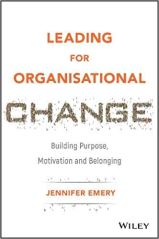
The Soft Underbelly: Why showing your vulnerable side is critical for change leaders
You would think, in our information age, with the depth and breadth of the research and thinking out there, that someone might have produced a blueprint – the definitive guide to how to lead well in every scenario.
You would think being at the helm in these enlightened times would be easier. And yet, it seems to be harder and more confusing than ever, and this sense that ‘the answer’ is out there can bring with it its own pressure – the perception that you need to get it perfect, a vision of managing every last detail, and the aspiration to keep a stern hand on everything and everyone involved in order to remain in control.
A counter-intuitive secret
The truth is, this will seldom work. When you’re facing change – and which leader isn’t? – you are entering a volatile, uncertain, complex and ambiguous environment. It is important to be able to take an evolutionary and emergent approach because you can’t possibly plan for every possible scenario, and you need to be able to adjust your course and guide your team.
And here’s the secret many leaders miss: research proves that this ability to be evolutionary and emergent requires a degree of vulnerability. Yes: You’re allowed to say you don’t have all the answers.
Argh. While we might understand this intellectually, it feels deeply uncomfortable, both personally and corporately. We inhabit a paradigm which equates leadership with expertise, problem solving, having all the best ideas, and being directive.
So, why is this a theory that we should be paying attention to in 2019? Well, as a starting point, it is abundantly clear from the business and political world around us that a point-blank refusal to engage with some vulnerability presents a major threat to trust and good decision making and leads to finger-pointing, question-dodging and hubris.
Secondly, there is a compelling and growing body of research which shows that leaders who show vulnerability are perceived as courageous and can inspire others to follow suit. In addition, the sheer act of admitting to not having all the answers frees others up – gives them the space, opportunity and agency to create, take initiative, innovate, and experiment.
Not weak or woolly
It’s important that we don’t confuse vulnerability with weakness or woolly thinking, and so this means it has to be framed properly:
- clearly placed within the context of the organisation’s purpose
- consistent with the organisation’s values, and
- positioned as part of the organisation’s particular narrative
This means you’re not sparking doubt by saying “I don’t know why ….”, or “I don’t know what’s important”, or “I don’t know where we are headed”. Instead, you are asking ‘how’ questions, for example:
“This is a new and complex challenge. I don’t necessarily know how to solve it on my own. Given what we’re about as an organisation, and our values and strengths, I know there must be lots of options. What does the team think?”
The vulnerability advantage
A leader who truly embraces this approach brings a multi-layered benefit to their organisation:
- they maximise the chances of finding a good solution to the particular problem in hand, by opening the floor to all of the talent, expertise and experience within the organisation;
- they establish the conditions which will make the generation of new ideas and the successful resolution of future problems much more likely;
- they role-model the trust and curiosity required to tackle complex issues;
- they create a space for others to step into and create and deliver.
Being vulnerable is still an alien concept for many of today’s leaders. But the science and the success stories tell you that it’s time to change. If your business is facing any type of change at the moment you may just have found your key ingredient.
Read more about Jen’s experiences in leading people, culture and change during the UK’s largest legal merger.






